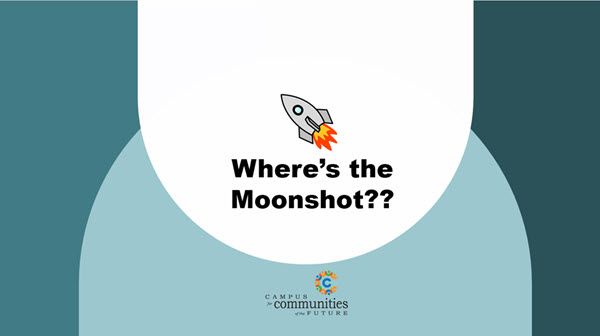Where’s the Moonshot???

Yes, but where’s the moonshot? That was a great question, one I was asked while working with members of Catalyst Now to prepare a session description for a global conference.
Not being an avid follower of space travel, I learned that a ‘moonshot’ describes an ambitious, bold goal that seems nearly impossible at first—one that requires new thinking, major collaboration, and extraordinary effort to achieve.
The term originated with US President John F. Kennedy’s 1962 challenge to land a human on the moon and return them safely to Earth within a decade. It was a goal that inspired innovation and united people around a common purpose.
As it turns out, the concept of a Moonshot is deeply relevant to today’s UN Sustainable Development Goals (SDGs).

United Nations Sustainable Development Goals
Like the original moonshot, the SDGs represent a set of grand, urgent challenges—combating climate change, ending poverty, ensuring quality education, and more—that demand transformative action, not just incremental change.
Achieving the SDGs requires the same spirit: setting audacious targets, mobilizing global cooperation, and harnessing creativity and technology to solve problems once thought insurmountable. In essence, the SDGs are the world’s collective moonshot for a better, more sustainable future.
While the SDGs may be our generation’s moonshot, the difference and the challenge are that the SDGs are more complex, difficult to convey and embrace, and more overwhelming than putting a human on the moon.
As a result, different messages and approaches must be considered.
Community-driven, Global by Design
In communities across Canada (and now beyond), it is becoming clear that the most significant insights and innovations often emerge not from the top down, but from the lived experiences and collective wisdom of communities themselves. Turns out, the real mission control might be your local community centre—minus the headsets, but with way better snacks.
By empowering communities to lead, we unlock new solutions to today’s challenges—solutions that are grounded in real needs and aspirations. Just as the space race demanded new understanding, so too does our quest for social progress require us to listen to, learn from, and follow the lead of those closest to the issues at hand.
Most importantly, we’re learning that the change we implement on a small scale at the local level can spark and reverberate at the global level.
Progress for All People
Kennedy insisted that advances must serve the progress of all, not just a privileged few. Because if progress only works for a few, it’s not ‘one giant leap’ for humankind. Leading from communities ensures that progress is inclusive and equitable. It moves us away from one-size-fits-all policies and funding toward approaches that genuinely uplift everyone.
When communities shape their futures, the benefits of progress—whether in health, employment, education, or opportunity-are more widely and fairly shared.
Collaborating and Measuring Our Best Energies and Skills
It’s more than one person making history in space, like Neil Armstrong as the first man on the moon or Canadian astronaut Roberta Bondar. Instead, it’s about giving everyone the opportunity to reach new heights together. Ultimately, that requires a different kind of leadership—collective, collaborative, and measurable.
So, while we may not all get a chance to go into space, we can still shoot for the stars from our own corner of the world—preferably with both feet firmly on the ground (and maybe a little less space dust).
Posted on 06-11-25
Next entry: Redefining Success: Balancing Prosperity, Well-Being, and Purpose
Previous entry: Staying Ahead of the Curve

 Brenda Herchmer is the owner of Grassroots Enterprises, a community development consulting company.
Brenda Herchmer is the owner of Grassroots Enterprises, a community development consulting company.